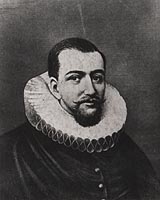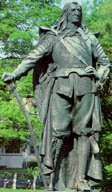Small Planet Communications, Inc. + 15 Union Street, Lawrence, MA 01840 + (978) 794-2201 + Contact







In the 17th century, New Amsterdam was a small trading and farming settlement on the southern tip of Manhattan Island at the mouth of the Hudson River. It had a magnificent harbor and a majestic river that provided access deep into the rich interior of the region. Its Dutch inhabitants, however, experienced much conflict.
The English eventually seized New Amsterdam, renamed it New York, and began to solidify and expand what would become one of America's most strategic and influential centers of trade, culture, and power.

Read about Henry Hudson.
The settlement of New York began with the exploration of the Hudson River. In 1609, English explorer Henry Hudson (the river's namesake) sailed as far as present-day Albany in the service of the Dutch East India Company. Although Hudson's mission to find a passage to the Indies failed, Hudson's employers were still pleased with the explorer's findings. Dutch interest was more in trade rather than colonization, and by establishing an outpost called Fort Nassau in 1614, the Dutch East India Company began participating in a lucrative fur trade with the local inhabitants.
Click to view a map of the
city of New Amsterdam
in the colony of New
Netherland in 1600.
In 1624, the first of seven ships loaded with colonists, supplies, and livestock was dispatched by the newly formed Dutch West India Company to establish the colony of New Netherland. Settling multiple forts along the Hudson River, including Fort Amsterdam on Manhattan Island and Fort Nassau (which would later become Fort Orange) at present-day Albany, the Dutch hoped New Netherland would become a prosperous farming and fur-trading colony.
The new colony developed slowly as the Dutch West India Company tried to populate New Netherland with a plan called patroonships. Patroonships were land grants given to anyone who, at their own expense, brought 50 people to settle on their patroon in the colony within four years. The system was unpopular because the company still retained rights to the fur and fishing trades, and very few patroons were successful.
DID YOU KNOW?
In 1626, Peter Minuit purchased
Manhattan Island from American
Indians with trinkets worth
60 guilders, which is equal to
about $24.
The principal economic activity on Manhattan Island and along the lower Hudson River was farming, which often brought the colonists into conflict with American Indians over land disputes. Initially, the Company tried to avoid such conflict as they purchased land from the American Indians. In 1626 Peter Minuit, the first Director-General of New Netherland, reportedly purchased the island of Manhattan from local American Indians with beads and other trinkets worth 60 Dutch guilders before formally founding the settlement of New Amsterdam on the southern tip of the island near Fort Amsterdam.
Fort Orange hosted the majority of the fur trade business for New Netherland. For the first few years, the company attempted to steer a middle course between the Mohicans, an Algonquian-speaking tribe, and the Mohawks, one of the nations of the Iroquois Confederacy, as the two groups battled for control of the area. After a Mohawk attack on the Mohicans in 1624, however, the Mohicans lost access to the Dutch traders.
Meanwhile, the growth of the colony had stagnated. Ownership of the colony was concentrated in the hands of a few wealthy persons. The company's monopoly on the economic life of New Netherland was eroding. A partial reorganization took place in 1640 when the West India Company gave up its trade monopoly. Other businessmen invested in New Netherland, bringing a flow of economic activity into the colony, including the production of food, timber, and tobacco.

Read more about
Peter Stuyvesant.
Peter Stuyvesant was appointed fourth and last Director-General of New Netherland in July 1646. Stuyvesant's dictatorial style helped boost the troubled colony. He restored order to the colony by issuing strict laws and making it mandatory to attend church. He insisted that American Indians be properly paid for the lands and services that had been taken from them. Stuyvesant bargained for captive Europeans from an earlier conflict with American Indians and eventually negotiated a peace treaty in 1660.
Dutch settlement was not confined to the Hudson River Valley; the Company also had claims to the Delaware River. These claims were disputed by Sweden, which had secured a charter specifically for the Delaware Bay region. Ironically, the first group of Swedes had been placed there in March of 1638 by the former governor of New Netherland, Peter Minuit, who established Fort Christina near present-day Wilmington. New Sweden was an entity that was under constant struggle. In 1655 under Stuyvesant's command, ships from New Amsterdam sailed south to the Delaware River where they took over the fledging settlement.
Click to learn more about
New Sweden in America.
Swedish encroachments were not the only problem facing the Dutch. More threatening was the spread of English settlements on Long Island and along the coast. The English saw the Dutch colony as a serious impediment, sandwiched between the two fast-growing areas of English settlement, the Chesapeake and New England. Conflict was inevitable. In 1664, during the Second Anglo-Dutch War, a British fleet seized New Netherland without firing a shot. Stuyvesant, with the fortifications at New Netherland still incomplete, found himself hopelessly outnumbered and surrendered under generous terms from the British Commander.

This map illustrates the locations of
the English and Dutch colonies in
New England in the 17th century.
Several important changes took place under British rule. In 1664, the king annexed New Jersey and gave it to his brother James, the Duke of York. Both the city of New Amsterdam and the colony itself were renamed New York, after the Duke of York. Fort Amsterdam became Fort James, and Fort Orange was renamed Fort Albany.
While control of the region changed hands several times after 1664, New York City served as a British military stronghold until the entire region was liberated after the Revolutionary War. New York joined the union as the 11th state on July 26, 1788.
New York | Bibliography
- Country Studies US. "New Netherland and Maryland." Accessed 5/30/19. http://countrystudies.us/united-states/history-8.htm
- Dunn, Richard S., Ph D. "John Winthrop, Jr., of Connecticut, The First Governor of the East End." September 12, 1998. East Hampton Library. Accessed 5/30/19. http://www.easthamptonlibrary.org/pdfs/history/lectures/19980912-2.pdf
- Encyclopædia Britannica. "Peter Minuit." Accessed 5/30/19. http://www.britannica.com/EBchecked/topic/384645/Peter-Minuit
- Encyclopædia Britannica. "Peter Stuyvesant." Accessed 5/30/19. https://www.britannica.com/biography/Peter-Stuyvesant
- Infoplease. "States by Order of Entry into Union." Accessed 5/30/19. http://www.infoplease.com/ipa/A0763770.html
- National Park Service. "Dutch Colonies." Accessed 5/30/19. https://www.nps.gov/nr/travel/kingston/colonization.htm
- New York State Museum. "Early Albany Timeline." Accessed 5/30/19. http://www.nysm.nysed.gov/albany/timeline.html
- Pocumtuck Valley Memorial Association/Memorial Hall Museum. "Glossary." Accessed 5/30/19. http://1704.deerfield.history.museum/list/glossary/all.do
- Public Broadcasting Service (PBS). "1628 Across the Continent." Accessed 5/30/19. http://www.pbs.org/wnet/colonialhouse/history/1628_northeast.html
- Public Broadcasting Service (PBS). "Peter Stuyvesant." Accessed 5/30/19. https://www.pbslearningmedia.org/resource/pnp377425eng/peter-stuyvesant-pnp377425-eng/
- University of Notre Dame, Department of Special Collections. "A Brief Outline of the History of New Netherland." Accessed 5/30/19. http://www.coins.nd.edu/
ColCoin/ColCoinIntros/NNHistory.html
New York | Image Credits
- Henry Hudson | Encyclopædia Britannica, courtesy of the Library of Congress
- Director General Peter Stuyvesant | Artist: Gertrude Vanderbilt Whitney, 1936; National Park Service: Cultural Resources
- Map of Dutch and English Colonization in New England | National Park Service: Cultural Resources
© 2020 Small Planet Communications, Inc. + Terms/Conditions + 15 Union Street, Lawrence, MA 01840 + (978) 794-2201 + planet@smplanet.com


